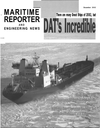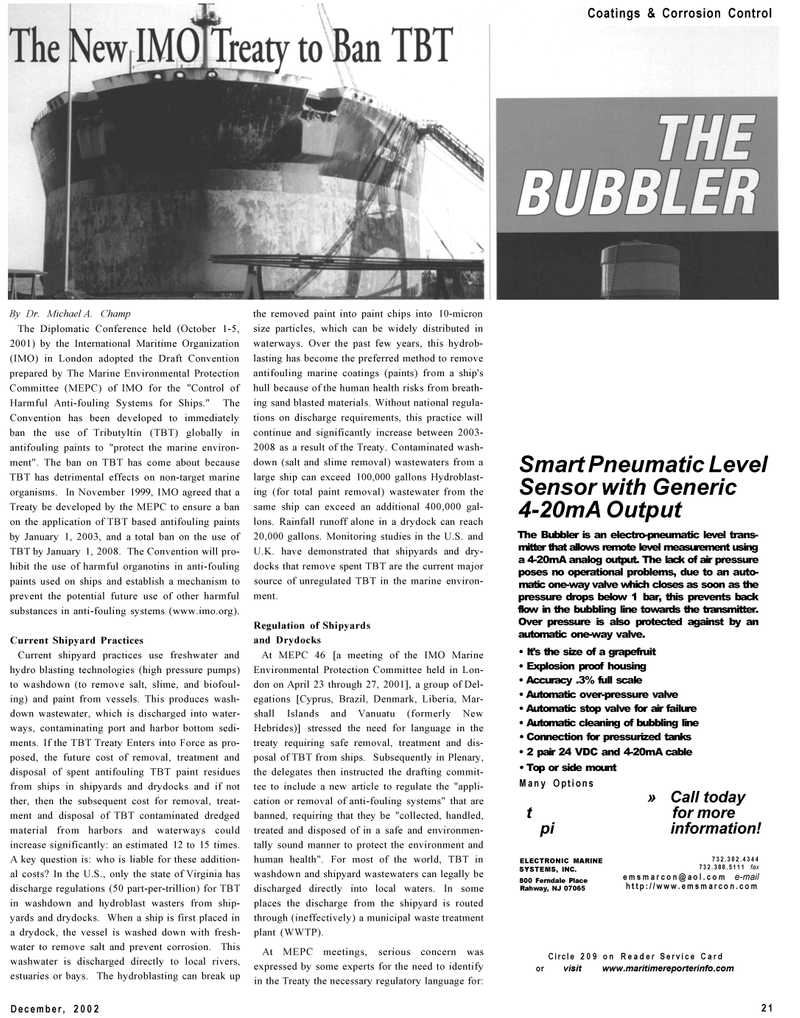
Page 21: of Maritime Reporter Magazine (December 2002)
Read this page in Pdf, Flash or Html5 edition of December 2002 Maritime Reporter Magazine
Coatings & Corrosion Control
By Dr. Michael A. Champ
The Diplomatic Conference held (October 1-5, 2001) by the International Maritime Organization (IMO) in London adopted the Draft Convention prepared by The Marine Environmental Protection
Committee (MEPC) of IMO for the "Control of
Harmful Anti-fouling Systems for Ships." The
Convention has been developed to immediately ban the use of Tributyltin (TBT) globally in antifouling paints to "protect the marine environ- ment". The ban on TBT has come about because
TBT has detrimental effects on non-target marine organisms. In November 1999, IMO agreed that a
Treaty be developed by the MEPC to ensure a ban on the application of TBT based antifouling paints by January 1, 2003, and a total ban on the use of
TBT by January 1, 2008. The Convention will pro- hibit the use of harmful organotins in anti-fouling paints used on ships and establish a mechanism to prevent the potential future use of other harmful substances in anti-fouling systems (www.imo.org).
Current Shipyard Practices
Current shipyard practices use freshwater and hydro blasting technologies (high pressure pumps) to washdown (to remove salt, slime, and biofoul- ing) and paint from vessels. This produces wash- down wastewater, which is discharged into water- ways, contaminating port and harbor bottom sedi- ments. If the TBT Treaty Enters into Force as pro- posed, the future cost of removal, treatment and disposal of spent antifouling TBT paint residues from ships in shipyards and drydocks and if not ther, then the subsequent cost for removal, treat- ment and disposal of TBT contaminated dredged material from harbors and waterways could increase significantly: an estimated 12 to 15 times.
A key question is: who is liable for these addition- al costs? In the U.S., only the state of Virginia has discharge regulations (50 part-per-trillion) for TBT in washdown and hydroblast wasters from ship- yards and drydocks. When a ship is first placed in a drydock, the vessel is washed down with fresh- water to remove salt and prevent corrosion. This washwater is discharged directly to local rivers, estuaries or bays. The hydroblasting can break up the removed paint into paint chips into 10-micron size particles, which can be widely distributed in waterways. Over the past few years, this hydrob- lasting has become the preferred method to remove antifouling marine coatings (paints) from a ship's hull because of the human health risks from breath- ing sand blasted materials. Without national regula- tions on discharge requirements, this practice will continue and significantly increase between 2003- 2008 as a result of the Treaty. Contaminated wash- down (salt and slime removal) wastewaters from a large ship can exceed 100,000 gallons Hydroblast- ing (for total paint removal) wastewater from the same ship can exceed an additional 400,000 gal- lons. Rainfall runoff alone in a drydock can reach 20,000 gallons. Monitoring studies in the U.S. and
U.K. have demonstrated that shipyards and dry- docks that remove spent TBT are the current major source of unregulated TBT in the marine environ- ment.
Regulation of Shipyards and Drydocks
At MEPC 46 [a meeting of the IMO Marine
Environmental Protection Committee held in Lon- don on April 23 through 27, 2001], a group of Del- egations [Cyprus, Brazil, Denmark, Liberia, Mar- shall Islands and Vanuatu (formerly New
Hebrides)] stressed the need for language in the treaty requiring safe removal, treatment and dis- posal of TBT from ships. Subsequently in Plenary, the delegates then instructed the drafting commit- tee to include a new article to regulate the "appli- cation or removal of anti-fouling systems" that are banned, requiring that they be "collected, handled, treated and disposed of in a safe and environmen- tally sound manner to protect the environment and human health". For most of the world, TBT in washdown and shipyard wastewaters can legally be discharged directly into local waters. In some places the discharge from the shipyard is routed through (ineffectively) a municipal waste treatment plant (WWTP).
At MEPC meetings, serious concern was expressed by some experts for the need to identify in the Treaty the necessary regulatory language for:
Smart Pneumatic Level
Sensor with Generic 4-20mA Output
The Bubbler is an electro-pneumatic level trans- mitter that allows remote level measurement using a 4-20mA analog output. The lack of air pressure poses no operational problems, due to an auto- matic one-way valve which closes as soon as the pressure drops below 1 bar, this prevents back flow in the bubbling line towards the transmitter.
Over pressure is also protected against by an automatic one-way valve. • It's the size of a grapefruit • Explosion proof housing • Accuracy .3% full scale • Automatic over-pressure valve • Automatic stop valve for air failure • Automatic cleaning of bubbling line • Connection for pressurized tanks • 2 pair 24 VDC and 4-20mA cable • Top or side mount
Many Options » Call today t for more pi information!
ELECTRONIC MARINE
SYSTEMS, INC. 800 Ferndale Place
Rahway, NJ 07065 732.382.4344 732.388.5111 fax [email protected] e-mail http://www.emsmarcon.com
Circle 209 on Reader Service Card or visit www.maritimereporterinfo.com
December, 2002 21

 20
20

 22
22
